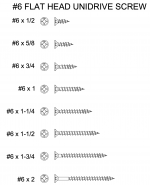I have a bunch of soft close Blum Door Hinges and Blum Drawer Slides to install. I will use both 5/8” (~16mm) and 3/4” (~19mm) screws. For other screws I have switched almost exclusively to GRKs/star drive. I have looked at my suppliers and online. I have not found any GRK or other star drive screws this short.
Anyone know if these might be available somewhere?
Thanks in advance.
Anyone know if these might be available somewhere?
Thanks in advance.

